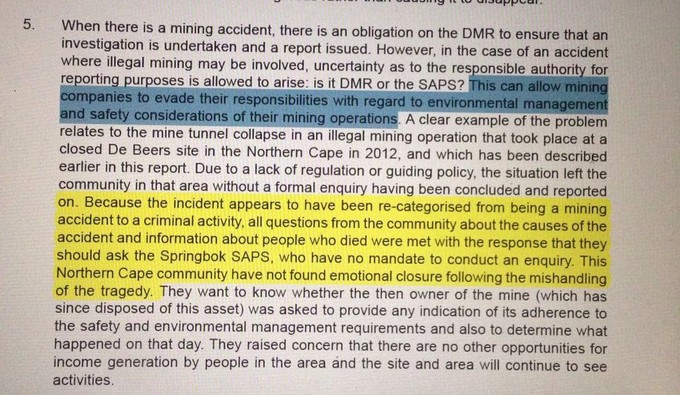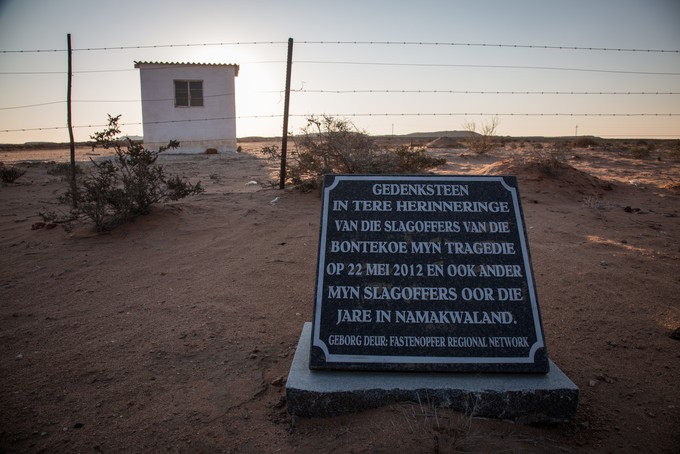Rough diamonds: De Beers responds
Life, not money, was our concern, says spokesman about company’s rescue effort at Bontekoe
GroundUp: In 1992, De Beers commissioned impact assessments by UCT researchers to investigate the consequences of mine closures in Namaqualand. Among other things, these assessments recommended slowing production to prolong the life of the mine. Instead, De Beers substantially boosted production while cutting costs via outsourcing. Why did the company choose to ignore the assessments? Does the company bare responsibility for high unemployment in the region that followed?
Tweedy: The fact is De Beers mine plan extended its operations by almost another 20 years after the 1992 social impact study and by suspending mining for various reasons it conserved the asset as an economically viable resource for a competent miner such that the mine has a future of many years ahead.
The proof that De Beers mined optimally is substantiated by the detailed production figures before and after 1992 for you to take account that production and grade do not support the conclusion you arrive at in your question which explicitly contends that there was a changing production or raising grade extracted – it is not an area of opinion as the facts illustrate that De Beers did not act as supposed.
The Company has an outstanding record of action in respect of continuing mining beyond the economic resource necessary for a diversified miner such as De Beers - a Company in various parts of the mining chain, such as in exploration which is a cost while most miners are just that, miners. There are obvious cost differences in overheads so what is viable and a going business for one is a loss making enterprise for another - as in any business. De Beers then ran a process to identify operators with the resources and ability to continue mining in the next phase of the operation.
De Beers provided employment and post employment pensions and managed the life of mine stages correctly and the allegation that “De Beers substantially boosted production after the 1992 social impact assessment” is not substantiated. I do not think there is a basis in fact to substantiate the accusation. The changes in mine planned production is demand-led. Hence drops illustrate weak demand thereafter recovering. However you will find those trends both before and after 1992. The grade illustrates no high grading occurred.
To give you a feel as to what happened production-wise before and after the 1992 study you refer to here are the facts in respect of production; how many carats was recovered each year and how many carats per hundred ton (cpht) was recovered from the material treated:
- 17.3cpht recovered on the production of 908,617ct in 1984
- 16.1cpht on 1,001,828ct in 1992
- 18.6cpht on 604,240ct in 1993
- 18.1cpht on 623,985ct in 1995
- 12.5cpht on 768,480ct in 1998
- 14.7cpht on 773,768ct in 2002
- 13.2cpht on 829,686ct in 2003
- 15.3cpht on 978,415ct in 2006
- 16.3cpht on 310,000ct in 2008 as the mine downscaled with the sale process.
The mine was put on the market in 2007 and post recession collapse in 2010. Plants were cleaned up before dismantling as a new mine plan for this stage of the resource production requires smaller more flexible plants for future mining.
- 71,000ct in 2009 clean up
- 97,000ct in 2010 clean up.
The mine sale process was stopped in 2008 due to the world wide economic recession which decimated the diamond market and capital markets. A new sale process began from scratch in 2010 with the final selection process concluding with the sale agreed in 2012. A period followed with regulatory approvals through to October 2014 when the mining rights to Namaqualand mines (NM) were transferred from De Beers to the current owners West Coast Resources.
Of the seven mining rights making up NM, De Beers has retained one, the oldest mining area known as BMC, where it continues to undertake its rehabilitation programme. Here we seek to not sterilise remaining ore reserves, so as to leave access areas to the remaining ore reserves, should the future owner seek to mine these.
GroundUp: The May 2012 illicit mine collapse, which killed ten people, took place on De Beers’ Strydrivier land. Why did the company immediately refer to the location as Bontekoe in press releases? Was this an attempt to circumvent an official inquiry from the Department of Mineral Resources (DMR), which is mandated to investigate all accidents on mining sites?
Tweedy: The De Beers press release has a brand naming the company and referred to the site name used to describe the accident site. De Beers was addressing the accident which occurred on our property and all appropriate authorities were notified when the company was notified by the SAPS to whom the accident had been reported by those aware of it happening. No authority responsible for such investigations was in any manner or way not offered the full cooperation of the management of NM or prevented from investigating the death of the diggers, rescue of one digger and the alleged flight of other diggers from the site.
As is known De Beers mounted an immediate rescue operation and later following the excavation of the site, search of the entire area where the tunnels reached and cooperated with the SAPS, DMR and all other authorities.
[Editor’s note: In this next paragraph the De Beers answer is particularly hard to understand. We have done our best to edit for clarity. We apologise in advance for any errors we might have inadvertantly introduced.] This was a tunnel that collapsed, not a mine. It was constructed in an overburdened area not previously mined by the company. It is an unmined area excavated via activity of a criminal nature at the site referred to as Bontekoe. To refer to it as Strydrivier would have confused the matter, even if we here had known the name, which we did not. The site of digging at Bontekoe was on the boundary fence with the access point used on the boundary.
Only when excavating the site to undertake the hoped for rescue had we first sight of the underlying tunnel direction into the boundary pillar area on the De Beers property.
It was not a mine site or a closed mine and this is an important point of fact relevant to investigating authorities. The NM mine was not a part of these diggings.
The investigation was a SAPS investigation at the crime scene. SAPS at national and other levels are continuing to address similar criminal activity both in the same region and elsewhere in other mining regions and sectors.
For the record there was no circumvention of any DMR process. De Beers was fully compliant with relevant laws. We did the correct thing.
GroundUp: How much money did De Beers spend on the Bontekoe rescue and recovery operation? Would this operation have taken place without De Beers assistance?
Tweedy: De Beers never considered the cost of the rescue action when the mine and company received notice of the tunnel collapse. Within minutes a decision was made … where the company committed the resources necessary. Outsourced expenditure was over R5 million for instance on rescue specialists and this cost excluded the internal company costs incurred. Life was our concern and the full excavation of the spaces where diggers might possibly be. It is not an option to speculate on what might have taken place in the absence of De Beers. It is however a fact which to our knowledge has not yet been reported that during the rescue and since no-one responsible for the activity of the diggers has acknowledged their accountability let alone taken public action to prevent similar criminal activities or their consequences.
GroundUp: Referring to accidents like Bontekoe, the SA Human Rights Commission has written about mining companies “evading responsibilities with regard to environmental management and safety considerations of their mining operations.” Has the company issued a response? Was the Bontekoe collapse formally investigated by DMR, as required by law?
Tweedy: Is this quote from the SAHRC in reference to De Beers? I have no factual reason to assume it is. De Beers attended the SAHRC public meeting on Bontekoe. The Company corresponded with the SAHRC. We are accountable for the legal obligations we have on our properties and can accept what we have responsibility and authority for.

GroundUp: What economic legacy has De Beers left in Namaqualand? Specifically, what happened to plans for aquaculture facilities, prisons, renewable energy farms, and mining rehabilitation projects — all advertised by De Beers as future industries for the region.
De Beers has a significant legacy for any company and one that has enabled past employees to create futures for themselves, for pensioners and at the time current employees to take advantage of preferential opportunities for housing when the mine towns were de-proclaimed and property transferred from the Mine ownership.
Specifically both the privately owned aquaculture operations continue under private ownership noting that De Beers invested in evaluating and inviting public interest in possible alternatives looking at the post mining future of the region. It is not something that a responsible and aware owner does overnight in a situation that the mine in decades past funded services otherwise provided by government and paid for by consumers.
The offer of facilities for use by the state as a prison was evaluated by interested parties and not taken up. However renewal energy opportunities attracted three serious parties and following their processes Eskom introduced a forth. We are optimistic such interest might well result in an approved – by the authorities – outcome.
[Editor’s note: We are simply unable to understand the next sentence and have left it unchanged.] The farms operated during De Beers tenure by mutual agreement and would post De Beers make suitable arrangements. Rehabilitation continues on our mining right area and more than one operator has provided services thereby developing services not dependent on the company. By a through selection process including ownership, community, rehabilitation capability and many other factors we have today West Coast Resources which have taken on SLP obligations and sustained a resource. The special needs school De Beers donated to Government to develop serves an area of hundreds of square kilometers - and houses and town maintenance equipment provided to the municipalities form but one part of a positive legacy naysayers fail to compare with business actions elsewhere in the sector or common elsewhere.
GroundUp: From De Beers’ perspective, what factors influence illicit diamond mining in Namaqualand, and what needs to be done to stop it?
Tweedy: Criminal activity is a conscious option taken by instigators and participants. It is either accepted or rejected by society broadly and specifically. It is a chain of many links strangling honest people in communities affected, be they near the theft site towns and villages or hiding in elite suburbs, far from the initial crime yet feeding off crime. The passive or greater tolerance for such crime than others affecting non mining communities undermines the best efforts of government, companies and civil society to expose, place in public court and punish all in the chain of self enrichment at the cost of honest communities and enterprises.
Support independent journalism
Donate using Payfast

Don't miss out on the latest news
We respect your privacy, and promise we won't spam you.
Next: Somalis fear for their lives after Tshwane riots
Previous: How to bribe your way to a licence in Johannesburg
© 2016 GroundUp. All rights reserved. (Note this article is not published under the Creative Commons license that we usually use.)

